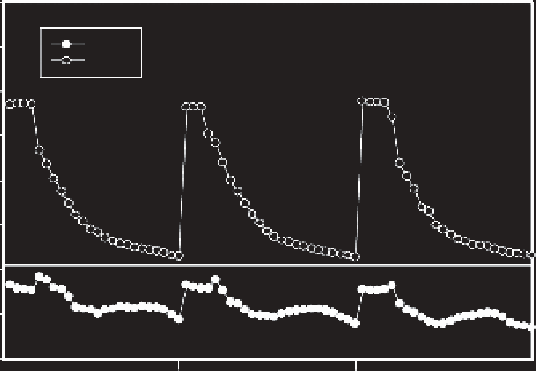Environmental Engineering Reference
In-Depth Information
often vertically stratify during the summer months, and the release temperature is a function of the
layers(s) from which the water is withdrawn. For example, a surface or bottom release may, if there
is suficient energy and a lack of stratiication, result in water being withdrawn from the entire verti-
cal proile. Alternatively, with less energy or a greater degree of stratiication, the withdrawal may
be conined to a relatively thin layer of the reservoir (either surface or bottom). Some reservoirs are
also equipped with selective withdrawal structures, so they can select the layers from which water is
withdrawn. These are all important in meeting downstream temperature objectives.
The temperature objectives will vary with the location and the ishery. For example, to maintain the
tailwater trout ishery below Buford Dam in Georgia, a peaking hydropower facility, the Georgia target
criteria are for temperatures below an instantaneous maximum of 22°C and below 20°C as a 5-day
average. Representative daily cycles in release temperatures and oxygen concentrations from Buford
Dam are illustrated in Figure 18.7. For the state of Oregon, the water-temperature standard for the lower
Columbia River is a 7-day average maximum temperature of 20°C, while the state of Washington regu-
lations state that the 1-day maximum should not exceed 20°C as a result of human activities.
The magnitude of the lows from a dam also inluences the downstream extent of the dam's
impact. For example, the existence of trout isheries in the tailwaters of many southern reservoirs
is dependent on the release of cold waters from the dam. The greater the magnitude of the releases,
often the further downstream the waters would remain at within the suitable temperature envelope
and support a viable ishery.
For mid-level or bottom releases, the concentrations of many water quality constituents are directly
inluenced by the seasonal progression of hypoxia in the hypolimnion of many reservoirs (Gore et al.
1990). Subsequently, concentrations are often much higher than would normally occur in natural streams.
18.3 REGULATORY ISSUES
18.3.1 L
IcenSe
c
ondItIonS
One of the regulatory issues discussed in Chapter 10 is that reservoirs typically have an approved design
purpose that is translated into speciic operation rules. These rules may often leave little lexibility in
the way that the reservoir can be operated for other purposes not included in the design purpose, such
as may be the case for the optimal management of tailwaters and downstream water uses.
40
35
DO
Te mp
30
25
20
15
10
5
0
Time (days)
FIGURE 18.7
Representative daily cycles in release temperatures and oxygen concentrations from Buford
Dam. (From WES,
The Handbook on Water Quality Enhancement Techniques for Reservoirs and Tailwaters
,
U.S. Army Corps of Engineers, Waterways Experiment Station, Vicksburg, MS, 1998.)

Search WWH ::

Custom Search